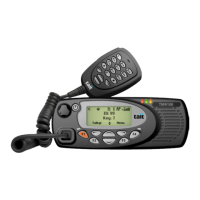7 General Information Tuneup
August 2004© Tait Electronics Ltd
Settings for
Receive Tests
For receive tests set the switches on the test unit as follows:
■
HOOK
switch :
“HOOK OFF”
■
MODE
switch :
“RX”
■
AUDIO IN
switch :
“OFF”
■
AUDIO OUT
switch:
“SPEAKER”
or
“LOAD”
In the last-named case, with the switch in the
“SPEAKER”
position, the
received audio is output from the test unit’s speaker. In the
“LOAD”
position a 16 Ω load is switched into the circuit in place of the test unit’s
speaker. Note, however, that the
AUDIO OUT
switch has no effect on the
radio’s speaker.
Settings for
Transm it Tes ts
For transmit tests set the switches on the test unit as follows:
■
HOOK
switch :
“HOOK OFF”
■
MODE
switch :
“RX”
initially
■
AUDIO IN
switch :
“MIC AUDIO”
■
AUDIO OUT
switch: (immaterial)
When ready to transmit, set the
MODE
switch to the
“TX/PTT”
position.
This switch functions in the same way as the PTT switch on the
microphone.
Product Support CD After setting up the test equipment for the first time, install the
programming and calibration applications on the test PC. These
applications are included on the product support CD supplied with the
service kit. Access the contents of the CD as follows:
1. Insert the product support CD in the CD-ROM drive of the test
PC.
2. The
Contents
window of the CD should appear; the window is
illustrated in Figure 1.3. If the
Contents
window fails to appear,
proceed as follows:
3. Click
“Start”
>
“Run”
. The
“Run”
dialogue box appears.
4. Type
d:\menu.exe
, where
d
is the letter designating the CD-ROM
drive.
5. Click the
“OK”
button. The
“Run”
dialogue box is closed and the
Contents
window appears.

